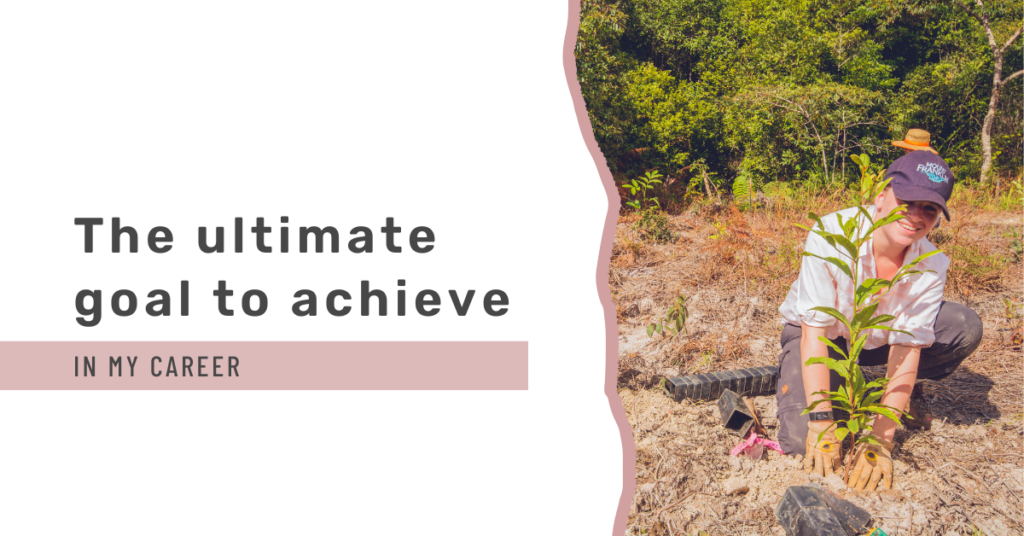The first half of 2019 was a memorable time for me as I embarked on an internship in Australia as part of my bachelor’s degree in Tropical Forestry. My internship journey actually began in Uganda, but I made the decision to discontinue it, which I’ll elaborate on later. In Australia, I found myself in the vibrant city of Cairns, located in Queensland. Where I spent a fulfilling four months working with the Cairns And Far North Environment Centre (CAFNEC). Alongside my internship responsibilities, I had ample opportunities to explore the beauty of Cairns and its surroundings.
One of my favourite activities during my time in Cairns was immersing myself in the lush tropical forest of a large park located right next to our office. It was an incredible experience to wander through the dense foliage. Surrounded by the sights and sounds of the tropical wilderness. Additionally, I embarked on a remarkable waterfall adventure in the Atherton Tablelands. An area west of Cairns that is renowned for its stunning waterfalls. These cascading wonders were undeniably beautiful, but I couldn’t help but notice just how refreshingly chilly the water was!
A highlight of my internship in Australia was the opportunity to spend several days exploring the Great Barrier Reef. It had always been a dream of mine to witness the breathtaking beauty of this natural wonder, and being able to do so was an absolute thrill.




Internship in Australia with CAFNEC
During my four-month internship in Australia, I worked with CAFNEC (Cairns And Far North Environment Centre), I had the opportunity to contribute to the organization’s environmental initiatives in Far North Queensland. Established in 1981, CAFNEC is a regional non-governmental environmental organization dedicated to safeguarding the unique natural heritage of the region. Their mission revolves around uniting the diverse community and other organizations to take action in support of a thriving natural environment in Far North Queensland. A place where the Great Barrier Reef meets the lush rainforest.
Far North Queensland boasts the distinction of housing two of Australia’s most iconic World Heritage Areas. the Great Barrier Reef and the Wet Tropics Rainforest. CAFNEC operates across four core areas: campaigns, projects, training, and facilitating connections among various stakeholders.
During my time at CAFNEC, I primarily assisted in roles behind the scenes. While I wholeheartedly supported their advocacy for the environment. I occasionally found myself outside my comfort zone when it came to direct outreach and public engagement. For instance, during my stint, the elections were approaching, and CAFNEC organized door-knocking campaigns to educate people about the importance of voting for political parties that prioritize environmental conservation. Although door-knocking is an effective method to reach a broad audience. I felt less confident participating in these activities due to my limited knowledge of the Australian government’s functioning.
Activities during this internship
Fortunately, there were numerous other tasks at CAFNEC that I could actively contribute to. One project I found particularly engaging involved assisting with the transition of their membership data into a new system. This process allowed me to delve into data management and help streamline their operations. Additionally, I had the opportunity to create content for several of their projects, each aimed at raising environmental awareness.
One of the projects I worked on was the Drain Stencil project. A unique initiative that involved taking young children to the streets and using stencils to spray-paint messages near drains. The aim was to educate the community about the direct link between what enters these drains and the resulting pollution in the Great Barrier Reef, an ecosystem of global significance.
Another significant campaign we were deeply involved in centred around the spectacled flying foxes. A remarkable bat species with a substantial colony in the heart of the city. Witnessing hundreds of these flying foxes hanging upside down in the large trees was truly awe-inspiring. However, there was a growing desire among some citizens and the government to remove the colony due to issues like street defecation and noise disturbances. Despite the challenges, it was clear that relocating these animals would be an incredibly stressful endeavour with no guaranteed success. Unfortunately, this complex issue continues to persist, highlighting the ongoing need for education and advocacy.




Atherton Tablelands
As part of my internship in Australia, I had the opportunity to spend 2.5 weeks in the Atherton Tablelands. A region known for its lush tropical rainforests. My university required me to conduct research as part of the internship. I had the fortune of conducting this research on a colleague’s property, which sat in an off-the-grid location bordering a vast nature reserve. The owners of this property were dedicated to its remarkable transformation, as they worked towards restoring it to its natural rainforest state. This endeavour was particularly significant since large portions of the land had been cleared for cattle farming before they acquired it.
The Atherton Tablelands is renowned for its frequent rainfall, and during our fieldwork, we often found ourselves racing against the clock to avoid massive afternoon showers. Surprisingly, I didn’t mind the rain at all; in fact, I found it to be part of the rainforest’s charm.
In addition to conducting research, I actively participated in reforestation efforts on the property. During my stay, there was a significant planting day organized, with plans to plant approximately 2000 seedlings. As you can envision, a considerable amount of preparation was necessary for this project. Workdays frequently brought scorching heat, with temperatures reaching up to 35 degrees Celsius, particularly when we were hunched over, tending to the soil or gathering essential data. However, after these intense and warm workdays, we frequently had the opportunity to cool off with a refreshing swim in a picturesque pond located on the property. If luck was on our side, we might even catch a glimpse of a platypus swimming alongside us. Unfortunately, these enigmatic creatures are known for their shyness, making sightings rare and fleeting.
Research on plant survival
During my stay in the Atherton Tablelands for my research, my primary focus was to evaluate the success of previous revegetation efforts. The property I was situated on had undertaken both seedling and seed planting initiatives in the past. My task was to assess which method proved to be the most efficient and successful in terms of plant survival. This entailed extensive fieldwork, where I meticulously counted all the plants that had been previously planted or had germinated from the seeds.
In total, I counted an impressive number of over 6,000 plants! The demanding fieldwork was, however, balanced with the rewarding experiences of swimming in the property’s pond or visiting nearby waterfalls. It truly felt like a dream to be living and working in such a breathtaking and ecologically diverse environment.




My previous internship in Uganda
As mentioned earlier, my journey to Australia for an internship followed a previous attempt in Uganda, which I ultimately decided to discontinue. This decision didn’t come lightly and was the result of careful consideration. My initial venture to Uganda took place in February 2018, driven by immense motivation and excitement. The plan was to spend five months in Kibale National Park. Conducting research on monkeys and comparing the replanted and primary rainforests. It felt like a dream come true.
However, the reality on the ground turned out to be vastly different from my expectations. I knew I would be in a remote location within the forest, but I wasn’t prepared for the level of isolation I experienced. While there were three other staff members. I only had the chance to interact with them for a brief 3-4 hours in the morning. The rest of the day, I was left on my own, unable to venture more than 100 meters from the house. Moreover, there was no access to electricity or the internet. If it were just the remoteness or the lack of modern amenities, I might have persevered. However, after discussing the situation with my friends, family, and school, we collectively agreed that it was in my best interest to discontinue the placement.
Naturally, not everyone understood or agreed with my decision. Some urged me to continue, warning me that I might regret quitting. Yet, to this day, I stand by my choice to return home and reassess my options. This experience taught me valuable lessons about myself and the importance of knowing when to make difficult decisions. While no one enjoys admitting defeat, I learned that there is no shame in trying your best and recognizing when a situation is not suitable for your well-being. Before leaving Uganda, I took the opportunity to explore the beauty of the country and its national parks. Witnessing African wildlife, including the iconic “Big Five.” A truly remarkable highlight was encountering mountain gorillas in Bwindi Impenetrable National Park. An experience that will forever hold a special place in my heart.
Want to support my work?
I spend a lot of time keeping this website filled with educational content and keeping updates about what I do to achieve my dream of working and living in Africa. Do you want to support me? You can buy me a coffee or purchase one of my digital prints. All proceeds will go towards my elephant research and the time spent on this website.







